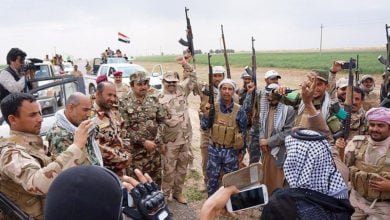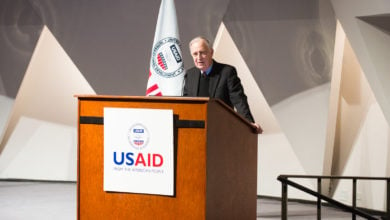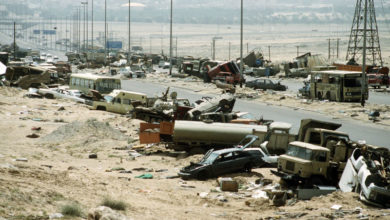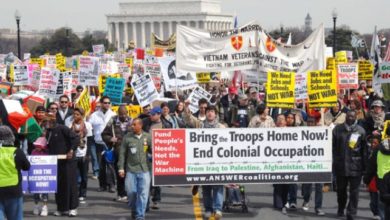 Despite the “unity government,” resistance to the occupation remains as strong as ever. Photo: Reuters/Hammurabi Organization |
On Nov. 19, 2005, 12 U.S. Marines executed 24 civilians in the Iraqi city of Haditha, supposedly in retaliation for the death of a fellow soldier. The Haditha killings were first reported in the March 27 issue of Time magazine.
It was a massacre. Whole families—men, women and children—were gunned down. The youngest victim was Zainab Rasif, a 2-year-old girl.
Initially, U.S. commanders implausibly reported that all the deaths were due to an improvised explosive device. Then, military personnel justified the murders as part of a heated combat situation, and suggested the soldiers had reacted to an ambush. “Soldiers in combat … can become stressed … and could snap,” said Brig. Gen. Donald Campbell, responding to questions about the killings.
In fact, the U.S. soldiers entered homes and methodically executed the residents.
The incident at Haditha is no anomaly. More atrocities are revealed on a regular basis.
For example, on May 30, two Iraqi women were killed because they did not stop at an observation checkpoint. One of the women was about to give birth. Her brother was driving the two women to the hospital.
“I was driving my car at full speed because I did not see any sign,” the brother stated. “It was not until they shot the two bullets that killed my sister and cousin that I stopped.”
On June 1, British BBC television released video footage of the murder of 11 civilians in Ishaqi, just north of Baghdad, in March. People ranging in age from 75 years to 6 months old were all ordered into a house and executed.
Following their murder, “the soldiers also burned three vehicles, killed the villagers’ animals and blew up the house.”
On June 3, U.S. Maj. Gen. William Caldwell announced the results of a Pentagon investigation of the Ishaqi massacre. He said the investigations found “no wrongdoing.”
“The investigation revealed the ground force commander, while capturing and killing terrorists, operated in accordance with the rules of engagement governing our combat forces in Iraq,” stated Maj. Gen. Caldwell. The statement did not refer to the killing of the 6-month-old child.
In fact, massacres and other atrocities have characterized the U.S. occupation of Iraq from the very beginning. On April 28, 2003, less than three weeks after the fall of Baghdad, U.S. troops fired into an unarmed crowd protesting the occupation in Fallujah, killing at least 13 people and wounding many more. One result was that Fallujah became a center of resistance.
To crush the resistance, U.S. air and ground forces annihilated the city in November-December 2004. Thousands were killed, although U.S. commanders carefully avoided recording the exact number of civilian and combatant deaths on the Iraqi side. More than 36,000 homes and 8,400 shops were destroyed. (Guardian, April 27, 2005)
Growing political instability
The revelations of the recent atrocities have put pressure on the puppet occupation government. On June 1, Iraqi “prime minister” Nuri Kamal al-Maliki charged that attacks against Iraqi civilians were a “regular occurrence.”
Al-Maliki had just been sworn in on May 20, along with a 40-member cabinet. The government has been touted in the big-business press as a sign of progress and a step toward a “unity” government.
“We’ve seen a lot of activities and events that give us a lot of hope and encouragement as we watch the leadership of the Iraqi government and the Iraqi (security forces) take greater control,” crowed Gen. Caldwell.
But as Caldwell and the Bush administration try to spin a happy tale, reciting a list of “turning points” in the war, the defiance of the Iraqi people continues to widen. Daily attacks against U.S. troops and their Iraqi lackeys continue in virtually every Iraqi city.
A report issued by the Department of Defense on May 30 suggests that an end to the resistance is not in the foreseeable future. The report, “Measuring Stability and Security in Iraq,” indicates that resistance activities in fact increased 13 percent between February and April of this year. “Enemy elements remain resilient,” the report states.
The “unity” government identifies its main three goals as “[fighting] the insurgency, [restoring] stability and [setting] the stage for the eventual withdrawal of U.S. and other foreign troops.” These statements reflect the wishes of the U.S. government. They in no way represent the vast majority of Iraqi people’s desire for the immediate withdrawal of all occupying forces.
The new government is another U.S. attempt to “Iraqize” the occupation, replacing the symbols of overt colonialism with a pro-U.S. political establishment and military force with an Iraqi face.
Fostering disunity
As the war continues, some in Washington’s halls of power have articulated visions of “victory” in Iraq that give lie to the claims of unity.
Sen. Joseph Biden has recommended dividing Iraq “into three largely autonomous regions, Kurd, Sunni Arab and Shiite Arab, with a weaker central government in Baghdad. It is increasingly clear that President Bush does not have a strategy for victory in Iraq.”
Biden, the ranking Democrat on the Senate Foreign Relations Committee, reflects the view of sectors inside the U.S government that would like to dismantle the Iraqi nation and its people in order to make the situation more “governable.” They legitimize this plan with the myth that the various religious groups in Iraq are incapable of peaceful coexistence.
The majority of Iraqi people have not identified themselves primarily by religious affiliation. The country is not neatly divided into religious or ethnic territories, as the U.S. government’s designations would imply. For example, the so-called “Sunni Triangle” around the city of Baghdad is in fact one-third Shiite Arabs, with large populations of Sunni Arabs, Kurds, Turkomens, Assyrians and others.
The basis for a wider anti-war movement
The Bush administration’s hopes for a stable, pro-U.S. puppet regime in Iraq cannot be achieved amid the widening insurgency. The fact that U.S. troops are turning their guns on civilians is a reflection of the fact that, like in Vietnam, the insurgency is rooted deeply within the Iraqi people.
No flowery rhetoric about “democracy” and “unity” can cover up the realities of U.S. occupation—the Hadithas, Ishaqis, Fallujahs and the hundreds of other massacres as yet unreported.
The growing reports of atrocities against Iraqi civilians are an opportunity for anti-war forces to bring the realities of U.S. occupation to broader layers of U.S. working people. They offer an opportunity to build real solidarity with the Iraqi people, who are fighting to live free of imperialist occupation.
They lay the basis for a wider, more militant opposition to the U.S. military occupation of Iraq and the whole Middle East.
Articles may be reprinted with credit to Socialism and Liberation magazine.






